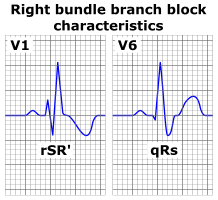Right bundle branch block: Difference between revisions
m (Robot: Automated text replacement (-{{reflist}} +{{reflist|2}}, -<references /> +{{reflist|2}}, -{{WikiDoc Cardiology Network Infobox}} +)) |
No edit summary |
||
| Line 20: | Line 20: | ||
{{SK}} RBBB | {{SK}} RBBB | ||
==Overview== | |||
'''Right bundle branch block (RBBB)''' results from a defect in the heart's electrical conduction system. There is a delay in failure of transmission of electrical impulses down the right bundle of the heart. As a result, the right ventricle depolarizes by an alternate mechanism. This is by means of cell-to-cell conduction. These cell to cell conduction impulses spread more slowly than usual from the interventricular septum to the [[left ventricle]] and to the [[right ventricle]]. This delay in conduction results in the characteristic [[ECG]] pattern which is a wide and notched [[QRS]]. Although conduction down the right bundle is delayed, conduction down the left bundle is normal. As result, the interventricular septum and [[left ventricle]] depolarize in the normal fashion. | |||
---- | |||
__NOEDITSECTION__ | __NOEDITSECTION__ | ||
==[[Right bundle branch block overview|Overview]]== | ==[[Right bundle branch block overview|Overview]]== | ||
Revision as of 16:46, 17 October 2012
| Right bundle branch block | |
 | |
|---|---|
| ECG characteristics of a typical RBBB showing wide QRS complexes with a terminal R wave in lead V1 and slurred S wave in lead V6. | |
| ICD-10 | I45.1 |
| DiseasesDB | 11620 |
|
Right bundle branch block Microchapters |
|
Differentiating Right bundle branch block from other Diseases |
|---|
|
Diagnosis |
|
Treatment |
|
Case Studies |
|
Right bundle branch block On the Web |
|
American Roentgen Ray Society Images of Right bundle branch block |
|
Risk calculators and risk factors for Right bundle branch block |
Editor-In-Chief: C. Michael Gibson, M.S., M.D. [1] Associate Editor-In-Chief: Cafer Zorkun, M.D., Ph.D. [2]
Synonyms and keywords: RBBB
Overview
Right bundle branch block (RBBB) results from a defect in the heart's electrical conduction system. There is a delay in failure of transmission of electrical impulses down the right bundle of the heart. As a result, the right ventricle depolarizes by an alternate mechanism. This is by means of cell-to-cell conduction. These cell to cell conduction impulses spread more slowly than usual from the interventricular septum to the left ventricle and to the right ventricle. This delay in conduction results in the characteristic ECG pattern which is a wide and notched QRS. Although conduction down the right bundle is delayed, conduction down the left bundle is normal. As result, the interventricular septum and left ventricle depolarize in the normal fashion.
Overview
Historical Perspective
Pathophysiology
Causes
Epidemiology and Demographics
Risk Factors
Natural History, Complications and Prognosis
Diagnosis
History and Symptoms | Physical Examination | Laboratory Findings | Electrocardiogram | Echocardiography | Other Imaging Findings | Other Diagnostic Studies
Treatment
Medical Therapy | Surgery | Primary Prevention | Secondary Prevention | Cost-Effectiveness of Therapy | Future or Investigational Therapies